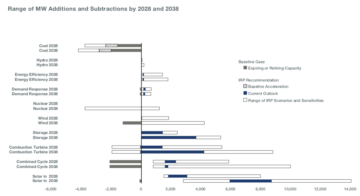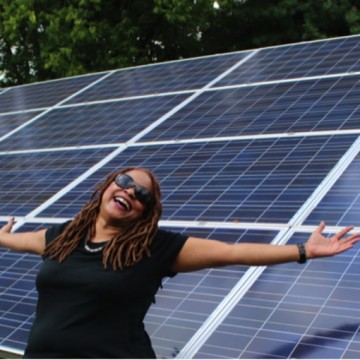TVA fails to deliver on energy efficiency, renewable energy, and transparency in their final IRP. But most of all, it fails its customers.
Maggie Shober | June 29, 2019 | Alabama, Energy Policy, Tennessee, UtilitiesLate Friday afternoon, the Tennessee Valley Authority (TVA) released its final Integrated Resource Plan (IRP) or long-term plan for its resource mix through 2038. An IRP determines where a utility will obtain energy, whether that be from clean and renewable sources, economic energy efficiency measures, or dirty and dangerous fossil fuels. The Southern Alliance for Clean Energy (SACE) submitted individual comments and a joint letter with NAACP, Tennessee Interfaith Power & Light, Appalachian Voices, and others to TVA staff on the draft IRP, and wrote a blog about those comments that you can find, here. Since TVA is a federally regulated utility, it do not engage in a state regulatory process with an elected Public Service Commission (PSC) like most utilities do, and is able to ignore any and all comments from stakeholders and customers.

Comments submitted by stakeholders and customers on TVA’s draft IRP mostly asked for more energy efficiency, more renewable energy, and more carbon reductions. TVA states there were comments both for and against coal plant retirements, though only 3 out of the 1,200 total were for the continued operation of fossil fuel power plants (both coal and gas). Therefore, it’s safe to say the vast majority of comments on TVA’s draft IRP urged the utility to move forward into the clean energy future.
Despite these comments, TVA did not make meaningful changes to the IRP between its draft and final form. In fact, instead of recommending one or a combination of the portfolios evaluated in the IRP process, TVA has lumped all the results together to provide a huge range for each resource, making the recommendation essentially useless. Typically in an IRP process, a number of possible futures and responses are analyzed and then compared using common metrics to choose one set of resource options or portfolio to pursue. TVA compared possible futures and responses, then lumped all the possible portfolios together to create the recommendation. An IRP is supposed to be a roadmap for the future. If you’re starting off on a road trip from Tennessee you can’t start without knowing if you are going to Maine, Michigan, California, or Florida. If TVA did not intend on picking a path forward, what is the point of going through the IRP process at all?

The TVA IRP states that in the next 10 years the utility will add anywhere from 1.5 to 8 GW of solar capacity and anywhere from 0 to 14.3 GW of gas capacity. That’s a range where the top end is at least five times the bottom end. Imagine you’re going out to eat and have hired a babysitter. You’re leaving at 6 PM and say to your babysitter you will return at either 7:30 PM or after 2 AM. I don’t think your babysitter will go along with that!
The statements about energy efficiency are even more insidious. The recommendation section of the IRP states that TVA is planning to “achieve savings of up to 1,800 MW by 2028 and 2,200 MW by 2038.” That statement leaves out the fact that the low end is zero. By including the entire range of portfolios in the “recommendation,” TVA is stating that there is a possibility that it does not invest a single dollar in energy efficiency between now and 2028.
Just as we highlighted in our comments on the draft IRP, the final IRP continues to show an underwhelming investment in energy efficiency and renewables. It also touts stakeholder involvement when in reality, TVA’s IRP process is significantly less transparent than IRPs that are reviewed by state regulators.
Lack of energy efficiency hurts customers
 In their two previous IRPs (2011 and 2015), TVA at least attempted to incorporate energy efficiency as a resource. But in this IRP, TVA makes clear their plans to gut energy efficiency investments, continuing a disappointing pattern in recent years of defunding efficiency programs that help their customers use less energy and save more money. TVA customers are already saddled with high electric bills driven by high usage and high fixed fees. These high fixed fees disproportionally hurt low-income, fixed income, and single-resident households and take away a customer’s ability to control their bills. In addition, homes that are not weatherized or have not installed energy-efficient appliances drive up energy usage – and customer bills. Today, TVA is well below the regional average on annual savings from energy efficiency. TVA trails far behind Duke Energy Carolinas, whose customers receive seven times the savings of customers in the Valley. Other neighboring utilities with higher energy efficiency savings than TVA include Georgia Power and Duke Energy Progress, which operates in both North and South Carolina.
In their two previous IRPs (2011 and 2015), TVA at least attempted to incorporate energy efficiency as a resource. But in this IRP, TVA makes clear their plans to gut energy efficiency investments, continuing a disappointing pattern in recent years of defunding efficiency programs that help their customers use less energy and save more money. TVA customers are already saddled with high electric bills driven by high usage and high fixed fees. These high fixed fees disproportionally hurt low-income, fixed income, and single-resident households and take away a customer’s ability to control their bills. In addition, homes that are not weatherized or have not installed energy-efficient appliances drive up energy usage – and customer bills. Today, TVA is well below the regional average on annual savings from energy efficiency. TVA trails far behind Duke Energy Carolinas, whose customers receive seven times the savings of customers in the Valley. Other neighboring utilities with higher energy efficiency savings than TVA include Georgia Power and Duke Energy Progress, which operates in both North and South Carolina.
To justify the indefensibly low-efficiency levels, TVA’s IRP analysis includes assumptions and constraints that produce limited energy efficiency results. Meaning that TVA just doesn’t believe there is a need for them to invest in efficiency as an energy resource. If TVA invested in energy savings programs it would lower participating customer bills directly and reduce the need for TVA to build more power plants in the future – thus lowering bills for all customers. By not investing in energy efficiency measures, TVA is perpetuating the current cycle of energy waste. In the short term, this means higher energy bills for all customers. In the long term, this means more unnecessary and expensive power plants. TVA certainly knows better and should do better on energy efficiency.
TVA continues to be a SunBlocker
Because the economics of solar are very hard to ignore, this IRP includes more solar than previous IRPs. However, under TVA’s current plan, the only near-term solar additions (online between now and 2023) are to meet the needs of business customers like Facebook and Google. TVA’s residential and small commercial customers are not afforded the same opportunity to reap the financial and environmental benefits of solar and are left to continue to rely on dirty energy sources like coal and gas.

Despite some scenarios projecting up to 14 GW of solar by 2038, TVA’s “current outlook” only reflects 2 to 3 GW by 2028 and 6 to 9 GW by 2038. These may seem like large numbers, but for the size of TVA’s system and the timeframe over which it is planned, the amount of solar is quite small. Florida Power & Light (FPL) has a system very similar in size to TVA and plans to install over 10 GW of solar over the next ten years. That’s right, FPL is adding more solar in 10 years than TVA is likely to add in 20. Also, unlike TVA, FPL is offering residential and commercial customers the opportunity to subscribe to and benefit directly from some of that solar through a community solar program.
It’s baffling that as a “public power” entity, TVA is not investing more in solar. TVA’s own analysis showed that building more solar would save money for the public it claims to serve. Investing in more solar would also avoid putting ratepayers on the hook for risky, long-term continued investments in non-renewable resources that adversely impact public health and customer pocketbooks. How can Tennessee be so far behind states like Florida, who installed more solar in one quarter this year (860 MW) than TVA claims it is capable of building in any single year between now and 2038 (500 MW)? When TVA removed arbitrary constraints from solar in their IRP analysis, solar additions increased as much as 50%. Clearly there is even more room for economic solar in TVA’s resource mix and it’s unclear why TVA isn’t taking advantage of this economic technology.
IRP process still lacks transparency
In our line of work, my colleagues and I look at a lot of IRPs. TVA’s final IRP does not provide the details to answer this key question: what resources will the utility use to meet customer needs in the near-term? The recommendation only includes what TVA plans in the next 10 years and what it plans in the next 20 years, nothing in between.
For instance, we had to go to Appendix G to get numbers instead of charts showing what resources would be added each year. Even then the numbers are rolled up into high-level categories like “renewable” and “gas” instead of providing insights on the specific technologies provided.
Ideally, an IRP would clearly state for each year what resources will be built and what resources will be retired. That way customers and stakeholders know what’s coming down the pipeline.
Where do we go from here?
The bright spot in TVA’s final IRP can be found in the “near-term actions” listed in the recommendation section. Here, TVA states that it intends to pursue a market potential study for energy efficiency and demand response, integrate distributed resource planning into its planning process, evaluate a battery storage demonstration project, and deploy initiatives to stimulate an electric vehicle market. These are actions we at SACE can get behind, and we hope TVA will pursue them quickly and through a transparent and meaningful stakeholder process. We look forward to collaborating with TVA on the implementation of each of these actions.
Want to take action? Join the movement to help SACE Renew TN and let’s move TVA forward into a clean energy future that works for everyone.